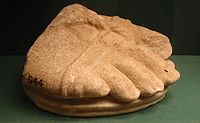Bassae (Latin) or Bassai, Vassai or Vasses (Greek, Modern: Βάσσες, Ancient: Βάσσαι), meaning "little vale in the rocks",[1] is an archaeological site at the northeastern of the Messinia Prefecture that was a part of Arcadia in ancient times. Bassae lies northeast of Kyparissia, south of Andritsaina and west of Megalopolis. It is famous for the well-preserved mid-5th century BCE Temple of Apollo Epicurius.
Although this temple is geographically remote from major polities of ancient Greece, it is one of the most studied ancient Greek temples because of its multitude of unusual features. Bassae was the first Greek site to be inscribed on the World Heritage List (1986).[2]
Temple of Apollo Epikourios
The temple was dedicated to Apollo Epikourios ("Apollo the helper"). It was designed by Iktinos, architect of the Temple of Hephaestus and the Parthenon.[1] The ancient writer, Pausanias places its construction as between 450 BC and 425 BC. It sits at an elevation of 1,131 metres[1] above sea level on the slopes of Kotylion Mountain.
Construction and decoration
The temple is aligned north-south, in contrast to the majority of Greek temples which are aligned east-west. This was necessitated by the limited space available on the steep slopes of the mountain. To overcome this restriction a door was placed in the side of the temple, perhaps to allow worshippers to face east or let light in to illuminate the statue.
The temple is of a relatively modest size, with the stylobate measuring 38.3 by 14.5 metres[3] containing a Doric peristyle of six by fifteen columns (hexastyle). It was constructed entirely out of grey Arcardian limestone[4] except of the frieze which was carved from marble. Like most major temples it has three "rooms" or porches: the pronaos, plus a naos and an opisthodomos. The naos most likely once housed a cult statue of Apollo. The temple contains optical refinements similar to those found in the Parthenon, such as a curved floor.
The temple is unusual in that it has examples of all three of the classical orders used in ancient Greek architecture: Doric, Ionic, and Corinthian.[1] Doric columns form the peristyle while Ionic columns support the porch and Corinthian columns feature in the interior. The Corinthian capital is the earliest example of the order found to date.[1]
It was relatively sparsely decorated on the exterior. Inside, however, there was a continuous Ionic frieze showing Greeks in battle with Amazons and the Lapiths engaged in battle with Centaurs.[5] This frieze's metopes were excavated by Charles Robert Cockerell and taken to the British Museum in 1815. (They are still to be seen in the British Museum's Gallery 16, near the Elgin Marbles.[5]) Cockerell decorated the walls of the Ashmolean Museum's Great Staircase and of the Travellers Club with plaster casts of the same frieze.[6]
Re-discovery and excavation

The temple had been noticed by German and French travellers, and parts were exposed in excavations by a team of scholars under Cockerell and Otto Magnus von Stackelberg in 1810 (including the frieze). However, the first full excavation was not begun until 1836. It was carried out by Russian archaeologists under the direction of Carlo Brullo. Perhaps the most striking discovery was the oldest Corinthian capital found to date. Some of the recovered artefacts are on display at the Pushkin Museum of Fine Arts in Moscow.
In 1902, a systematic excavation of the area was carried out by the Greek Archaeological Society of Athens under archaeologist Konstantinos Kourouniotis along with Konstantinos Romaios and Panagiotis Kavvadias. Further excavations were carried out in 1959, 1970 and from 1975-1979, under the direction of Nikolaos Gialouris.[1]
Preservation
The temple's remoteness has worked to its advantage for its preservation. Other, more accessible temples were damaged or destroyed by war or by conversion to later religious uses, the Temple of Apollo escaped both these fates. Due to its distance from major metropolitan areas it also has less of a problem with acid rain which quickly dissolves limestone and damages marble carvings.
The temple of Apollo is presently covered in white tent with five rows in order to protect the ruins from the elements. Conservation work is currently being carried out under the supervision of the Committee of the Epicurean Apollo, which is based in Athens.


No comments:
Post a Comment